Glasgow, Paisley and Greenock Railway
Introduction
This line is open and carries a regular electric train passenger service between Gourock, Greenock, Paisley and Glasgow Central as well as branch traffic to Wemyss Bay. Between Glasgow Bridge Street and west to Paisley (now Gilmour Street) the Glasgow and Paisley Joint Railway was used (joint with the Glasgow, Paisley, Kilmarnock and Ayr Railway). From Paisley the line strikes north west crossing farmland and former bog to reach Bishopton and the tunnels which required much work to build through hard volcanic rock. Beyond the line going west, following the south bank of the widening River Clyde to pass through Port Glasgow and reach Greenock. Existing steamer concerns were not keen to provide links. They were, after all, losing traffic between Glasgow and Greenock. For its opening in 1841 the company created the Railway Steam Packet Company. This company bought steamers to provide onward links to Clyde piers and had further new steamers built. It was wound up in 1846, steamers transferred to G & J Burns who would provide the onward travel. The GP&GR was taken over by the Caledonian Railway in 1851 and the former company's works was to become the larger company's works until it built the St Rollox Works in 1854.
Dates
Route described
Glasgow Bridge Street to Paisley (jointly owned with the Glasgow, Paisley, Kilmarnock and Ayr Railway) and on to Greenock.
Portions of line and locations
This line is divided into a number of portions.
Paisley to Greenock
This is the principal station in Paisley (Paisley Canal is a terminus.) It is on both the line between Glasgow Central and Greenock Central, Gourock, Wemyss Bay and the line to Ardrossan, Largs, Ayr, Girvan and Stranraer.
...
See also
Glasgow, Paisley, Kilmarnock and Ayr Railway
Glasgow and Paisley Joint Railway

...
Bill Roberton 14/10/2023

Colin Kirkwood 08/04/1966

...
Network Rail /12/2021
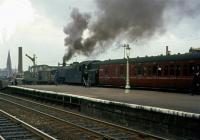
Colin Kirkwood 14/09/1963
This junction was at the west end of Paisley station (renamed Paisley Gilmour Street in 1883). It is sometimes also referred to as 'Stoneybrae Junction'. This was an end on junction between the Glasgow and Paisley Joint Railway and the junction between the Glasgow, Paisley and Greenock Railway and Glasgow, Paisley, Kilmarnock and Ayr Railway.
...
See also
Glasgow, Paisley, Kilmarnock and Ayr Railway
This twin frame box, opened 1888, was west of Paisley Gilmour Street. It controlled the two separate routes west from the station: to Greenock and Ayr. In addition there was a connection between the lines via a short headshunt exchange siding.
...
See also
Glasgow, Paisley, Kilmarnock and Ayr Railway

G H Robin collection by courtesy of the Mitchell Library, Glasgow 21/03/1955
Having crossed the White Cart Water and passed through Paisley Gilmour Street the line to Greenock continues at a high level via the Underwood Viaduct to Paisley St James.
...
This was the Caledonian Railway's mineral yard in Paisley, entirely owned by that company.
...
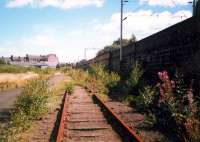
Ewan Crawford //1987
This is a two platform station on the Glasgow - Gourock line. There is no car park.
...

David Panton 13/07/2019

G H Robin collection by courtesy of the Mitchell Library, Glasgow 27/08/1963

Brian Haslehust 03/04/1965

G H Robin collection by courtesy of the Mitchell Library, Glasgow 16/05/1964
This junction for the [1902 [Paisley and Barrhead District Railway]] was just west of Paisley St James station on the 1841 Glasgow, Paisley and Greenock Railway. In its final days the branch was a single track serving the former Pressed Steel Co Ltd works.
...
See also
Paisley and Barrhead District Railway

Ewan Crawford //

G H Robin collection by courtesy of the Mitchell Library, Glasgow 10/04/1953
This was the northern of a triangle of lines at Walkinshaw. The junction allowed a train from the Barrhead direction to join the Greenock line. The Caledonian Railway's plan was to create a route fully owned by the CR between Greenock and Glasgow via Barrhead and Cathcart via the Paisley and Barrhead District Railway. It was redundant after the grouping of 1923 which brought the CR and ...
More detailsSee also
Paisley and Barrhead District Railway

G H Robin collection by courtesy of the Mitchell Library, Glasgow 16/05/1964

G H Robin collection by courtesy of the Mitchell Library, Glasgow 27/08/1963

G H Robin collection by courtesy of the Mitchell Library, Glasgow 16/05/1964

G H Robin collection by courtesy of the Mitchell Library, Glasgow 16/05/1964
Also known as the Walkinshaw Refinery or Hermand Oil Works. The oil works was located close to what became Walkinshaw Branch Junction. The works was connected to nearby pits to north and south by a private railway (Walkinshaw Ironstone Pits).
...
This junction was north west of Paisley and was the location where the single track Linwood Goods [CR] branch joined the Glasgow, Paisley and Greenock Railway. It had a connection into the Clippens Oil Works at Linwood.
...
See also
Linwood Branch (Caledonian Railway)

G H Robin collection by courtesy of the Mitchell Library, Glasgow 27/08/1963

G H Robin collection by courtesy of the Mitchell Library, Glasgow 27/08/1963

G H Robin collection by courtesy of the Mitchell Library, Glasgow 27/08/1963
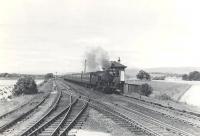
G H Robin collection by courtesy of the Mitchell Library, Glasgow 27/08/1963
This was a two platform station. There was a main station building similar to that at Bishopton on the eastbound platform and shelter on the westbound. The signal box was just north of the main building. The eastbound platform was reached by an access road from the south and the westbound by a footway rising from the roadway to the south, and there was a footbridge between the platforms.
...

Ewan Crawford //1987
This junction was north of Georgetown station and south of Southbar Junction. The box at Southbar had burned down in 1934 and the box here replaced it. The box was on the east side of the line. Barochan Junction was named for Barochan House, moss and hill which are off to the west.
...
This Great War period station was built to serve the Georgetown National Filling Factory, to the west. The station was south of Southbar Junction and Georgetown National Filling Factory Yard on a loop line on the west side of the main line. To the south was Houston station.
...
This marshalling yard was on the west side of the main line. Approach from the north was from Southbar Junction and from the south from near Houston station.
...
See also
ROF Bishopton Standard Gauge Railway
The Glasgow, Paisley and Greenock Railway crossed this area on an embankment due to the low lying marshy ground. This junction, named for Southbar House to the north east, served a large tip. Waste was tipped on either side of the line to the north of the junction to reclaim the marsh by Glasgow Corporation. Tipping sidings, such as Southbar Siding (East) were moved as needed.
...
This is a two platform station with an original station building on the southbound (up) platform. There are car parks on the old goods yard south end of the station, east side of the line and shunted from the south) and an area of ground to the west.
...

John McIntyre 27/04/2017

John McIntyre 27/04/2017

G H Robin collection by courtesy of the Mitchell Library, Glasgow 02/06/1964

G H Robin collection by courtesy of the Mitchell Library, Glasgow 02/06/1964

Ewan Crawford 03/01/2007
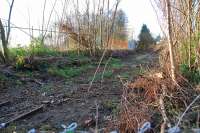
Ewan Crawford 27/11/2011
This double track tunnel is west of Bishopton. It is 330yds long. Bishopton No 2 Tunnel is just to the west.
...

Ewan Crawford //1998
This double track tunnel is west of Bishopton and Bishopton No 1 Tunnel. It is 350yds long.
...

Ewan Crawford 03/01/2007
About 333 yards west of Bishopton No 2 Tunnel is a class 'AM' listed cast iron aqueduct which carries a small burn over the railway, the burn draining from south to north. The engineer was William MacKenzie.
...

Ewan Crawford 03/01/2007
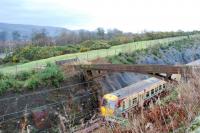
Ewan Crawford 03/01/2007
This signal box was west of Bishopton No 1 Tunnel and Bishopton No 2 Tunnel. The location was north east of Laigh Hatton farm and it was on the north side of the line. It controlled a trailing crossover.
...

G H Robin collection by courtesy of the Mitchell Library, Glasgow 17/07/1962

G H Robin collection by courtesy of the Mitchell Library, Glasgow 17/07/1962

G H Robin collection by courtesy of the Mitchell Library, Glasgow 28/08/1963

Robin McGregor 30/06/1966
This is a two platform station with a good view of the River Clyde from its platforms.
...

G H Robin collection by courtesy of the Mitchell Library, Glasgow 10/07/1962
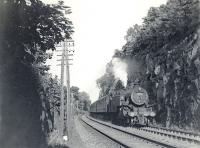
G H Robin collection by courtesy of the Mitchell Library, Glasgow 26/05/1964
This signal box was west of Langbank and east of Woodhall stations. It was on the north side of the line alongside a trailing crossover. There was a level crossing. For the crossing initially the spelling Parklee was used, becoming Parklea at a later date. The spelling 'Parklee' was used for the box until closure in 1966.
...

G H Robin collection by courtesy of the Mitchell Library, Glasgow 23/06/1964

G H Robin collection by courtesy of the Mitchell Library, Glasgow 28/08/1963

G H Robin collection by courtesy of the Mitchell Library, Glasgow 23/06/1964

G H Robin collection by courtesy of the Mitchell Library, Glasgow 21/09/1963
This is a two platform station in Woodhall, to the east of Port Glasgow. The station has a footbridge and small station building on the westbound platform. The station was built after housing was built on the Woodhall estate.
...

G H Robin collection by courtesy of the Mitchell Library, Glasgow 30/07/1963

G H Robin collection by courtesy of the Mitchell Library, Glasgow 30/06/1964

G H Robin collection by courtesy of the Mitchell Library, Glasgow 30/07/1963

John Furnevel 29/07/2007
At the east end of the sidings of Port Glasgow Goods was a short branch on the north side which made a trailing connection to the eastbound line. This short branch served Lamont's Castle Yard (a shipyard just east of Newark Castle and the Fyfe Park Shipbreaking Yard. The location was simplified by taking the connection out, the yards could be reached via a line, now a headshunt, ...
More details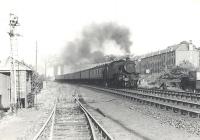
G H Robin collection by courtesy of the Mitchell Library, Glasgow 30/07/1963
This junction was east of Port Glasgow station. It was the junction for Port Glasgow Goods which was on the south side of the line and approached from the east and the Port Glasgow Harbour branch. To the east were further sidings at Fyfe Park.
...

G H Robin collection by courtesy of the Mitchell Library, Glasgow 20/07/1963

G H Robin collection by courtesy of the Mitchell Library, Glasgow 20/07/1963

G H Robin collection by courtesy of the Mitchell Library, Glasgow 20/07/1963

G H Robin collection by courtesy of the Mitchell Library, Glasgow 20/07/1963
This goods yard was half a mile east of Port Glasgow station. It no longer exists and its site had been robbed for a road system.
...

G H Robin collection by courtesy of the Mitchell Library, Glasgow 30/07/1963
This is a two platform station with a fine large glazed canopy on the Glasgow bound platform, slightly smaller canopy on the Gourock bound platform, a covered walkway to Princes Street and a traditional covered footbridge.
...

Network Rail /07/2023

G H Robin collection by courtesy of the Mitchell Library, Glasgow 20/07/1963
This junction is west of Port Glasgow station. It is the junction between the Glasgow to Greenock line (the 1841 Glasgow, Paisley and Greenock Railway) and the 1Wemyss Bay line (the 865 Greenock and Wemyss Bay Railway).
...
See also
Greenock and Wemyss Bay Railway
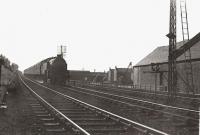
G H Robin collection by courtesy of the Mitchell Library, Glasgow 05/06/1962

G H Robin collection by courtesy of the Mitchell Library, Glasgow 27/06/1964

G H Robin collection by courtesy of the Mitchell Library, Glasgow 27/06/1964

G H Robin collection by courtesy of the Mitchell Library, Glasgow 05/06/1962
This is a minimal two platform station. It is approached by stairs from a bridge carrying Bogston Road at the east end.
...

David Panton 07/03/2019

David Panton 07/03/2019

G H Robin collection by courtesy of the Mitchell Library, Glasgow 27/06/1964

G H Robin collection by courtesy of the Mitchell Library, Glasgow 05/06/1962

Graham Morgan 31/08/2007
This was the junction for the short branch from the Greenock to Paisley line which ran north to the James Watt Dock. The dock opened partly in 1885 and fully in 1886. This branch was approached from the east and turned from heading west to north to east on a sharply curved and steeply graded line which dropped down to Inchgreen Goods and reversing lines from which the dock was reached by ...
More details
Ewan Crawford //1988

Ewan Crawford /05/1989
This double ended shed was located to the south of the Glasgow, Paisley and Greenock Railway between Cartsdyke and Bogston station. Approach was from the west. The shed was severely damaged by bombing in the Second World War.
...

Colin Kirkwood 29/02/1964

Colin Kirkwood 23/02/1963

Colin Kirkwood 29/02/1964

Colin Kirkwood 29/02/1964
This is a two platform station to the east of Greenock Central. The main station building was on the eastbound platform.
...

Brian Haslehust //1967

G H Robin collection by courtesy of the Mitchell Library, Glasgow 05/06/1962
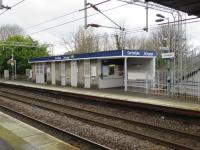
David Panton 07/03/2019
This junction was west of Cartsdyke. Going west the line divided into three portions which were, from north to south:
...

G H Robin collection by courtesy of the Mitchell Library, Glasgow 30/06/1964

G H Robin collection by courtesy of the Mitchell Library, Glasgow 13/08/1964

Robin McGregor 28/04/1967

G H Robin collection by courtesy of the Mitchell Library, Glasgow 30/06/1964
This was on the north side of the railway in Greenock, served from Cartsdyke Junction to the east. Further east again was Cartsdyke station. In particular the yard served the nearby shipyards and engine works bringing in coal and metalwork (and taking out swarf from the works).
...
The location was by the terminus Greenock, opening with the line in 1841. The works and shed were alongside each other.
...
This was a foundry and engine works on the south side of the Glasgow, Paisley and Greenock Railway bounded to the east by the Carts Burn. It was the engine works of Scott, Sinclair & Co. (The engine works of Scotts Shipbuilding & Eng Co Ltd.)
...
The Glasgow, Paisley and Greenock Railway main works and engine sheds were located at Greenock, close to the terminus. Opening around 1841 with the line.
...
This signal box was on the eastern approaches to Greenock Central and its goods yards. It was located on the south side of the line east of Dellingburn Street.
...
See also
Gourock Extension Railway (Caledonian Railway)
This is the main station in Greenock. It replaced Greenock Cathcart Street [1st] which was the original terminus of the line. The original terminus line was located slightly to the north and the line was cut back to the new station on opening. In addition the new alignment was further north in general. To great local disappointment Greenock Mansion House was demolished as part of the works. ...
More detailsSee also
Gourock Extension Railway (Caledonian Railway)

Roger Geach Collection /06/1992

Brian Haslehust //1967

Brian Haslehust //1967

Ewan Crawford //1999
This station was a terminus. It was close, but not actually at, Greenock Harbour. It was above street level (described as a 'considerable height') and a set of steps ran from the entrance down to the street. Offices were on the ground level and the platforms were above street level. There was a colonnaded front with an archway on either side. It was close to the harbour but not on a railway pier. ...
More details
Abercorn Branch
This is a two platform station on the Glasgow - Gourock line. There is no car park.
...

David Panton 13/07/2019

G H Robin collection by courtesy of the Mitchell Library, Glasgow 27/08/1963

Brian Haslehust 03/04/1965

G H Robin collection by courtesy of the Mitchell Library, Glasgow 16/05/1964
The works of A F Craig & Co Ltd (founded by Archibald Fulton Craig in 1868, company formed 1895). This was a general engineering works, making carpet looms, sugar mills and the shale oil industry (the Abercorn Oil Works was to the north).
...
Castle Yard Branch
At the east end of the sidings of Port Glasgow Goods was a short branch on the north side which made a trailing connection to the eastbound line. This short branch served Lamont's Castle Yard (a shipyard just east of Newark Castle and the Fyfe Park Shipbreaking Yard. The location was simplified by taking the connection out, the yards could be reached via a line, now a headshunt, ...
More details
G H Robin collection by courtesy of the Mitchell Library, Glasgow 30/07/1963
This was the shipbreaking yard of Smith & Houston Ltd. The SS L'Atlantique was broken up here in 1936, PS Mountaineer in 1938, and former HMS Perseus in 1958. It was located on the eastern edge of Port Glasgow on the south bank of the River Clyde. The Castle Yard was immediately to the west and Port Glasgow Gas Works to the east. The site was rail served.
...
This shipyard, James Lamont & Co's Castle Yard from 1929/30, was located to the east of Newark Castle in Port Glasgow. The yard largely built ferries and small craft, and Clyde steamers were maintained here. The site was equipped with, from west to east, building berths and plating shed, a fitting out basin and (latterly) a pair of patent slips. Closure was in 1979. The site is now ...
More details
Ewan Crawford 29/06/1997

Brian Haslehust //1967
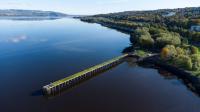
Ewan Crawford 18/10/2022

Brian Haslehust //1967
Port Glasgow Harbour Branch
This junction was east of Port Glasgow station. It was the junction for Port Glasgow Goods which was on the south side of the line and approached from the east and the Port Glasgow Harbour branch. To the east were further sidings at Fyfe Park.
...

G H Robin collection by courtesy of the Mitchell Library, Glasgow 20/07/1963

G H Robin collection by courtesy of the Mitchell Library, Glasgow 20/07/1963

G H Robin collection by courtesy of the Mitchell Library, Glasgow 20/07/1963

G H Robin collection by courtesy of the Mitchell Library, Glasgow 20/07/1963
This shipyard is located on the south bank of the lower Clyde in the east end of Port Glasgow. It is immediately to the west of Newark Castle [Port Glasgow]. Ship building continues today and the yard has been almost entirely rebuilt and thoroughly modernised Ferguson Marine .
...

Ewan Crawford 18/10/2022

John McIntyre 29/06/2021
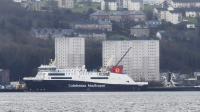
Ewan Crawford 21/02/2023
Cartsdyke Branch
This junction was west of Cartsdyke. Going west the line divided into three portions which were, from north to south:
...

G H Robin collection by courtesy of the Mitchell Library, Glasgow 30/06/1964

G H Robin collection by courtesy of the Mitchell Library, Glasgow 13/08/1964

Robin McGregor 28/04/1967

G H Robin collection by courtesy of the Mitchell Library, Glasgow 30/06/1964
This John G Kincaid and Co Ltd engine works was located on the south side of Main Street/East Hamilton Street in Cartsdyke. The works was served by a short branch from Cartsdyke Junction.
...

Ewan Crawford //1996
Greenock Harbour Branch [2nd]
This junction was west of Cartsdyke. Going west the line divided into three portions which were, from north to south:
...

G H Robin collection by courtesy of the Mitchell Library, Glasgow 30/06/1964

G H Robin collection by courtesy of the Mitchell Library, Glasgow 13/08/1964

Robin McGregor 28/04/1967

G H Robin collection by courtesy of the Mitchell Library, Glasgow 30/06/1964
This engine works was in Greenock north of the Glasgow, Paisley and Greenock Railway. It was started by John Caird and became the engine works of Caird & Co. In 1916 the company was bought by Harland & Wolff Ltd and the engine works was sold to John G Kincaid and Co Ltd in 1919. Closure was around, or before, 1988 and the site has been cleared.
...

Brian Haslehust /10/1965

A Snapper (Courtesy Bruce McCartney) 02/08/1959

A Snapper (Courtesy Bruce McCartney) 20/08/1959

Colin Miller 27/10/2011
This was a ship building yard bounded to the east by the Carts Burn and to the west by the other shipyards of Rue End (later supplanted in 1846 by construction of the Victoria Harbour). The Cartside Yard was equipped with a dry dock for the owners, Robert Steele & Co. Having both slips and a dry dock allowed the company to not only built and fit out ships but also carry out ship repairs ...
More detailsScott & Co bought the Cartside Ship Yard and Cartsdyke West Yard from Robert Steele & Co in 1883. The two yards and the timber yard in between were merged to form the Cartsburn Shipbuilding Yard. The timber ponds between the yards were to be rebuilt as a fitting out basin in 1904.
...

Brian Haslehust 11/12/1965

Brian Haslehust //1965

Brian Haslehust //1964

Brian Haslehust 11/12/1965
This dock was opened in 1824 on the west side of East India Harbour (1805), Greenock. It was built to the south of the western part of the harbour, west of the dock entrance. The sides were stepped. The Greenock Customs House was just to the north west. The southern side of the dock was passed by a dockside line from the Glasgow, Paisley and Greenock Railway.
...

Brian Haslehust 11/12/1965

Ewan Crawford //1999

Brian Haslehust 08/03/1964
Greenock Harbour Branch [1st]
This station was a terminus. It was close, but not actually at, Greenock Harbour. It was above street level (described as a 'considerable height') and a set of steps ran from the entrance down to the street. Offices were on the ground level and the platforms were above street level. There was a colonnaded front with an archway on either side. It was close to the harbour but not on a railway pier. ...
More details
Brian Haslehust /10/1965

A Snapper (Courtesy Bruce McCartney) 02/08/1959

A Snapper (Courtesy Bruce McCartney) 20/08/1959

Colin Miller 27/10/2011

Brian Haslehust 11/12/1965

Brian Haslehust //1965

Brian Haslehust //1964

Brian Haslehust 11/12/1965




















